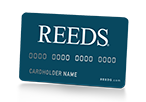This is a demo store. No orders will be fulfilled. (1368487-reeds-pro-web-1.reeds.com)
Jewelry Care & Cleaning
Jewelry may be some of our most prized and valuable possessions. We buy fine jewelry expecting it to last a lifetime, and hopefully, that it will be handed down to future generations. Yet many of us don't know how to take care of jewelry properly. In order for fine jewelry to retain it's beauty, luster, polish and shine, it needs to be appropriately tended. The following section sets out some basic guidelines for the care and cleaning of gemstone jewelry, diamonds, and precious metals.
A Few Basic Rules of Jewelry Care
- Remove jewelry when working in the kitchen, garden, or while cleaning.
- Clean jewelry regularly. Soap and oils from fingerprints can significantly detract from jewelry luster and shine.
- Apply makeup before putting on jewelry. Chemicals in cosmetics, hairspray, perfumes and lotions can often damage metals, pearls and other types of jewelry.
- Avoid wearing jewelry in swimming pools and spas. Chlorine can react with metals causing color and structural damage,
- Contact Sports and jewelry don't mix. Hard blows can dislodge a gemstone from its setting.
- Separate pieces of jewelry when storing it. Contact can lead to abrasion.
- Heat can fracture gems. Store gemstone jewelry in a temperate location.
- Fine jewelry should be regularly inspected to ensure that stones are securely set.
Caring for Diamonds
It's tough to hurt a diamond. It's the hardest natural substance on Earth: it takes a temperature of 1292 Fahrenheit to burn; and the only thing that can cut a diamond is another diamond. So, why do we need to take care of diamond jewelry? It's simple, dirt and oils can collect on the surface and under the setting and cause diamonds to lose their special sparkle. Even the oil from a person's fingertip is enough to smudge the surface and diminish its brilliance.
Diamonds jewelry should be cleaned regularly. There are many ways to clean diamonds. Every week or so, they can be soaked overnight in an ammonia based household cleaner like Windex or a commercial jewelry cleaner. Do not use chlorine bleaches or abrasive cleaners or toothpaste as they may corrode or loosen the metal setting. The next step is brushing the diamond with a soft, previously unused toothbrush.. Special attention should be paid to brushing the area around the setting where dirt is most likely to collect. If the metal setting is soft or old, its a good idea to scrub very gently. Finally, rinse the diamond with water and wipe it dry with a soft, lint-free cloth.
Diamond jewelry may also be cleaned using an ultrasonic cleaner. These special cleaners use sound waves along with a cleaning fluid to remove dirt. These machines should be used with caution because they may loosen settings and damage antique metals in estate jewelry..
Caring for Gemstone Jewelry
How one cleans gemstone jewelry greatly depends on what gemstones the jewelry is fashioned with. Hard gemstones such as diamonds, rubies and sapphires must be treated very differently from softer gemstones such as opals, pearls and onyx. As mentioned in the above section regarding diamonds, ultrasonic cleaning machines are generally safe for use with hard gemstones with newer settings. (Note: don't try to clean more than one piece of jewelry at a time in Ultrasonic cleaners as contact may cause damage.) Some jewelers suggest using a pulsed dental cleaning appliance as a way to wash dirt from settings. To clean softer gemstones, Reeds recommends using commercial jewelry cleaner or water mixed with a small amount of dish washing soap as a cleaning solution. Gently wash the jewelry with a soft cloth or clean brush, then rinse with water and dry. Always make sure that drains are closed if jewelry is being cleaned in a sink in the event stones become lose from their settings.
Things to Note about Specific Gemstones
- AMBER:
- Amber is a soft gemstone. Do not use an ultrasonic machine. Amber may darken over time when exposed to too much light.
- AMETHYST:
- Amethyst is an extremely durable stone that will withstand normal cleaning. Excessive light or direct heat may fade or weaken the gemstone's color.
- AQUAMARINE:
- Do not use an ultra-sonic machine. Heat may cause discoloration.
- CITRINE:
- As quartz, citrine is able to withstand normal cleaning. Excessive light or direct heat may fade or weaken the gemstone's color.
- EMERALD:
- Because emeralds are oiled and usually included to some degree, this stone should not be placed in an ultrasonic cleaner. Emeralds should be cleaned gently with a small brush and lukewarm water. Avoid sudden temperature changes and sharp blows.
- GARNET:
- Garnet is an extremely durable stone and will withstand normal cleaning.
- OPAL:
- Opal is a soft stone that requires care when cleaning. Do not use an ultrasonic cleaner, abrasive, or ammonia based cleaner. Clean with a soft cloth or occasionally a combination of a mild non-detergent soap (such as Woolite®) and warm water with a soft brush. If overheated, opals may turn white or brown, develop tiny cracks, and even lose their play-of-color. Opals draw moisture from the air so storage is very important. A dry area, such as a safety deposit box, can actually do more harm than good.
- PEARL:
- Pearls are delicate. After each wearing, clean with a soft cloth. Never use an ultrasonic cleaning machine, abrasive or ammonia based cleaner. Periodically clean with very mild non-detergent soap (Woolite®) or a commercial jewelry cleaner made specifically for pearls. If pearls must be brushed, use a soft makeup brush instead of a toothbrush. A wet string may stretch and attract dirt, so lay the strand on a clean towel and avoid touching until the pearls are completely dry. There are many rules in safe-guarding delicate pearls. Pearls are soft and easily scratched. Heat can lead to cracking and discoloration.. Avoid contact with perfumes, cosmetics, hairspray and household cleaners as they may damage the nacre. Have a jeweler periodically and professionally clean and restring pearls. Cultured pearl necklaces should be strung with knots between each bead. Pearls draw moisture from the air so they should be stored in a dry area.
- PERIDOT:
- Do not use an ultra-sonic machine. Avoid sharp blows and sudden temperature changes.
- RUBY:
- Rubies are hard gemstones. However, the color enhancement technique used in many stones may result in fading over time. Fading may be accelerated over time by harsh treatment or exposure to strong chemicals or abrasives. Avoid direct heat.
- SAPPHIRE:
- Because the heat treating process is permanent, sapphires are an unusually durable stone. Use normal cleaning care. Avoid direct heat.
- TANZANITE:
- Clean with mild soap and water; do not use an ultrasonic machine. Avoid sudden temperature changes and sharp blows.
- TOPAZ:
- Care should be taken when cleaning a topaz of any color. Do not use an ultrasonic machine. Avoid prolonged exposure to light and heat, as well as sharp blows or sudden temperature changes.
Care of Precious Metals
Often the most difficult part of protecting gemstone jewelry is the metal setting. Everyday substances like hairspray, lotions, perfumes, or other cosmetics may corrode the alloys used in a setting or in metal jewelry. Exposure to chemicals can discolor gold, silver and platinum as well as other metals. Ammonia, one of the chemicals most commonly used in household cleaners is particularly harmful. Chlorine bleach, another common household solvent, can cause pitting in gold alloys. Metal jewelry may be cleaned with commercial cleaning solvent or with mild detergents such as dish washing liquid. You should consider the softness and age of the metal before selecting a cleaning brush. Toothbrushes are fine for harder, newer metals while soft make up brushes are a good option for older and softer metals. Dry thoroughly with a soft, lint-free cloth.
Water, oils, and even air can cause metals to tarnish. When not using jewelry, especially sterling silver, its a good idea to store it an an anti-tarnish bag or cloth.
Storing Jewelry
One of the most vital things to consider in the care of jewelry is probably the thing we are most likely to overlook, and that is storage. Jewelry that's jumbled in a box with other pieces of jewelry is often scratched, tarnished and even broken. Jewelry boxes and travel pouches that provide padding, separation and tarnish resistant materials are the best way to protect your jewelry investment. Not only will these jewelry boxes protect your jewelry, but they can reduce the amount of cleaning needed. If you do not have a jewelry box that pads and separates, the box or pouch that the jewelry arrived in is a great place to safeguard and store jewelry.
Additional Information
We recommend the following websites as sources of information on jewelry care and cleaning:
- American Gem Society's (AGS) Guide to Fine Jewelry Care Includes tips on storage, wear, cleaning and protecting your fine jewelry.
- Gemological Institute of America (GIA)
- Jewelry Information Center (JIC)
*Note: Clicking on these external links you will bring up a window to a third party site that is not reeds.com. REEDS Jewelers, Inc. does not verify, validate, warrant or endorse any product or information found on this third party site.


